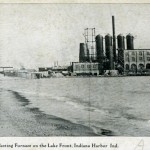A “place for the millions of pent-up city folk to seek refuge, quiet and renewal.” That was the way US Senator Paul H. Douglas envisioned the dunes on the south shore of Lake Michigan.
The Illinois legislator became known as the “Third Senator from Indiana” in the 1950s by virtue of the passion with which he took up the cause of the preservation of this natural sanctuary.
Douglas ‘s efforts to protect the Indiana dunes were anticipated the burgeoning environmentalism of the late 1960s, but were by no means the first attempts to halt the encroachment of development and industry in this ecologically unique area.
Professor Henry Cowles of the University of Chicago had conducted extensive studies in the Dunes from 1896 through 1934, determining that the geological and botanical diversity of the area represented the legacy of the changes wrought by the Ice Age.
From a dune ridge to the bog that neighbors it, vegetation in the region may vary from pines to orchids.
Recognizing the Dunes’ significance as a natural site and recreational haven, groups calling themselves “Friends of the Native Landscape” and “the Prairie Club” were galvanized at the turn of the century by the expansion of the Chicago-based steel industry eastward into Indiana.
Though many legislators and civic leaders in Indiana welcomed this prospect for economic growth, environmental groups bemoaned the destruction of dunes, dredging of shorelines and set-up of factory towns in their beloved landscape.
Though World War One delayed early efforts, the groups ultimately obtained authorization through the state’s new Department of Conservation for a 2,182-acre Indiana Dunes State Park, which opened its gates on July 1, 1926.
The Save the Dunes Council was born of the concern over the residential sprawl and industrial development that continued over the next few decades, intensified by the 1959 opening of the St. Lawrence Seaway, connecting the Great Lakes to the Atlantic Ocean.
With the help of Senator Douglas, and the precedent established by the 1961 entry of Cape Cod National Seashore into the National Parks System, the Indiana Dunes National Lakeshore was authorized in 1966.
The groups ultimately obtained authorization for which opened its gates in 1926.
The Save the Dunes Council was born of the concern over the residential sprawl and industrial development that continued over the next few decades, intensified by the 1959 opening of the St. Lawrence Seaway, connecting the Great Lakes to the Atlantic Ocean.
With the help of Senator Douglas the Indiana Dunes National Lakeshore was authorized in 1966.






















